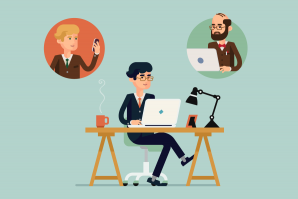For the past several weeks, thousands of American workers who normally might have been gathered around the office water cooler have instead found themselves standing solo at their own kitchen counters — sans colleagues but still very much “at work.”
As a result of the coronavirus stay-at-home orders across most states, workers have been switched to telecommuting at rates that were unthinkable even a few months ago. Though more than half of U.S. employees hold jobs that could be performed in a “flexible workspace” such as at home, according to the Bureau of Labor Statistics, only 7 percent were given the option to do so prior to the outbreak. Global Workplace Analytics, which has been studying remote work trends for more than a decade, predicts that 25-30 million U.S. employees will regularly work from home within the next two years — compared to five million who currently do so at least half-time.
Click here for more coronavirus coverage
As Zoom meetings become the new normal for those who work from home, there are certainly benefits to be seen. Air pollution has dropped precipitously as car commuting has slowed. Nitrogen dioxide emissions have declined by 30-60 percent all over the world.
Some people are finding more time for family, as well as more energy to complete minor tasks that used to feel overwhelming at the end of a long day at the office. For others, the shift to working from home has been more challenging, especially with day care facilities and schools closed, leaving children at home too. There’s also a technological learning curve involved for some workers and a need for companies to supply the tools for people to work remotely.
The question is: Where do we go from here? “A lot of this will stick — but not all of it,” says Peter Schwartz, chief future officer at Salesforce and a member of Gov. Gavin Newsom’s newly formed California Future of Work Commission. Schwartz is a renowned futurist and has projections for what a post-pandemic workplace might look like.
“I think this is going to change the nature of the office,” Schwartz says. “It’s going to be a place where we come together, not where we do work. The reason people want to go to an office is to be with other people — we’re naturally gregarious animals. Informal communications don’t happen when working alone via electronic means.”
This paradigm shift will also affect infrastructure. Schwartz predicts offices will be reconfigured into conversation lounges, not individual desks, and instead of owning large buildings to house scads of employees, businesses will start renting flexible workspace through coworking companies like WeWork to support a smaller footprint for day-to-day operations.
But like any futurist, Schwartz also says the lingering effects of this situation have yet to be seen. “This is a moment of experimentation,” he says. “What does productivity look like? Are we more productive at home, where there are fewer distractions? The truth is, we don’t know yet. The metrics have to evolve. We’re part of a huge learning phenomenon.”
No one knows that better than those who have been tasked with transitioning the workforce from in-person to online. Andrew LaMar, deputy director of communications for the California Department of Human Resources, says the biggest challenge for the state has been to move so many so quickly to teleworking. Though he thinks the efforts will certainly pay off, he’s not entirely sure how.
“This is a great opportunity for the state and its employees to see how teleworking on a large scale works,” LaMar says. “We’re learning new ways to communicate and collaborate in order to do our jobs, and that’s very exciting. I think it will be quite instructive to departments, which are getting a chance to see the advantages and disadvantages of using (telecommuting) widely. And at the end of the day, we will all benefit from that.”
LaMar says that, anecdotally, he sees workers being more attentive to email correspondence, which is a definite advantage of working from home. But at the same time, he’s seeing a loss of the “social aspect of the office culture,” which lends credence to Schwartz’s prediction that what we get out of the workplace will change.
Ultimately, the future of teleworking post-pandemic might not be crystal clear, but one thing is certain: This major societal shift in how we work could be an opportunity. “People are spending more time with their families,” Schwartz says. “There’s less traffic, clean air. Maybe we’d like to keep a lot of that. The next question is: How do we do that?”
–
Stay up to date on the effects of the coronavirus on people and business in the Capital Region: Subscribe to the Comstock’s newsletter today.
Recommended For You

Help for Displaced Workers
What employers and employees need to know about job protection and wage replacement during the COVID-19 pandemic
In the COVID-19 pandemic, business as usual has been upended and employers and employees are facing uncharted territory. Comstock’s spoke with Roseville-based employment law attorney Drew Lewis about what job protection and wage replacement programs are available in the Capital Region.

The Coronavirus Challenge
The pandemic is exposing cracks in our systems, but it’s also an opportunity to strengthen systems
Before the outbreak and spread of the new coronavirus, disruptive technologies, global competition and instant 24/7 connectivity made forecasting difficult. Today, the sheer magnitude and instability triggered by COVID-19 has made the road ahead far less clear. Or has it?

So You Want to Try Telecommuting
3 steps to get you started
Telecommuting is a hot topic around many water coolers and a popular office perk, particularly for enticing young professionals. But while it may be commonplace in a number of companies, deciding if it is right for your team takes careful consideration. If you do choose to enable telecommuting, a few simple policies can make the process smoother.

On the Move
Is taller, denser housing near transit hubs right for the Capital Region?
City officials and developers are eyeing transit hubs for residential projects — but can it be effective in the Capital Region, which lacks the mass transit hubs of larger cities?




Comments
The issue is management letting people work from home. We know it works. It is unreasonable to expect employees work in an office when working from home is just as good or better. It is completely unreasonable and irresponsible to ask employees to work in an office when working from home is a safer option in the wake of a global pandemic with another flare up expected in the fall